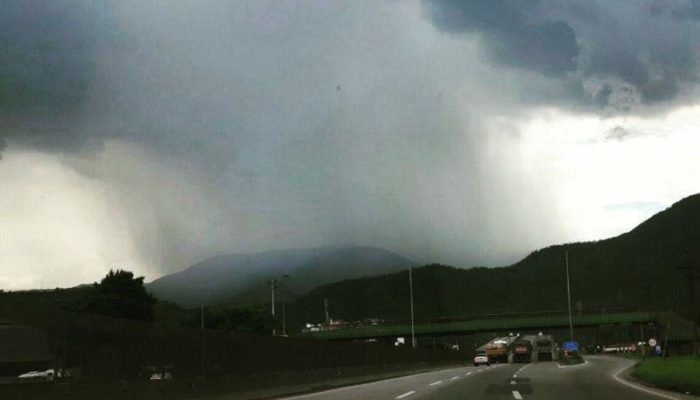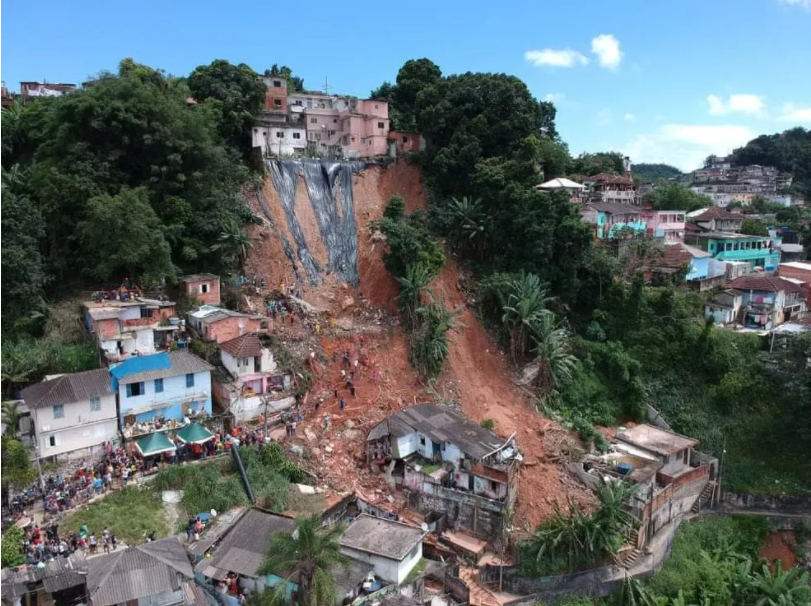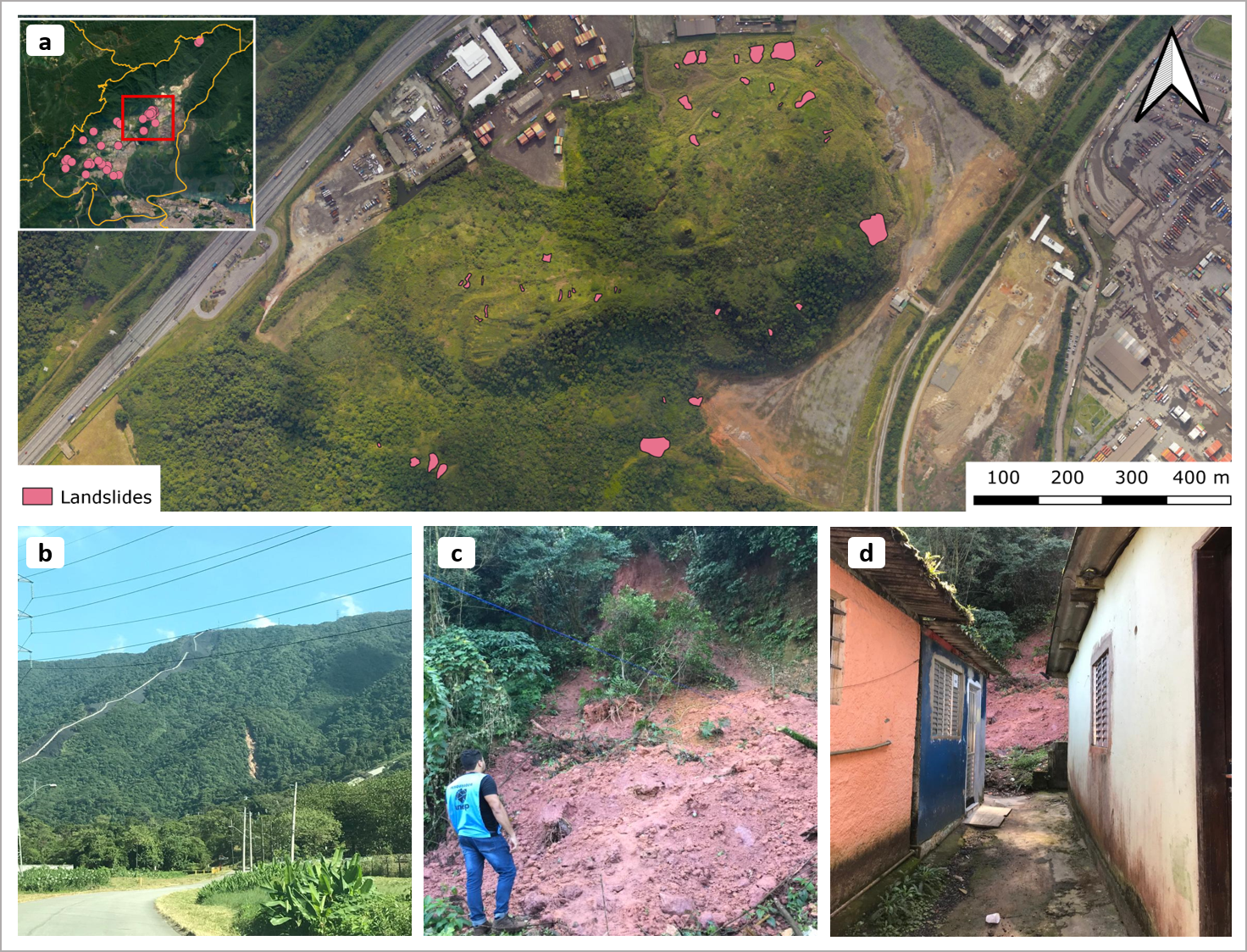
In summer 2020, extreme rainfall events dumped up to 320 mm of rain in a single day in the Baixada Santista metropolitan region, São Paulo state, breaking Brazil’s record for the biggest rainfall in a single event and demonstrating one of the greatest threats of climate change. The damage caused by the associated landslides led to dozens of fatalities and hundreds of homeless people, as well as serious disturbances in the most affected cities of Guarujá, Santos and São Vicente. Guarujá was the worst scenario and concentrated the highest number of deaths. Here the accumulated rainfall for the 7 days before the disaster was 668 mm.
Intense heat and high humidity are typical characteristics of the summer months in the Baixada Santista region, with frequent occurrence of the so-called ‘summer rains’, which are convective rainfall events. However, the rainfall that occurred in the afternoon of March 02, 2020, exceeded all the expectations compared to the rainy events that occurred in the past seasons. The rain gauges of the National Center for Monitoring and Alert of Natural Disasters (CEMADEN) recorded in just 24h an accumulated rain of 320 mm, 239 mm and 207 mm for the cities of Guarujá, Santos and São Vicente, respectively [1].
Most of the impact was caused by the associated landslides, which led to 44 fatal victims and leaving 612 people homeless (Figure 2), serious disturbances such as flooding on public roads, as well as roadblocks and falling trees. To understand the severity of the event, two firefighters who were trying to rescue two victims under the debris were also buried by a second landslide [2,3]. Also, indirect impacts affected services such as transportation, education, water supply, electricity and telecommunications, causing problems to the logistics network in the region and delaying the agility of assistance actions to displacements and victims. Because of the damage, the state of public calamity was declared.
Although the Human Development Index (HDI) of the affected sites is above the country’s average (Santos being the sixth largest) [4], almost all areas, where fatal landslides occurred, are inhabited by low-income people, increasing exponentially the pre-existing social inequalities of the area. These populations live in precarious urban settlements (favelas), generally arranged in hilly areas (as shown in Figure 2), or covered by mangroves. The concern also extends to people visiting these cities for work or tourism, as they are appealing tourist destinations and in summer they attract millions of tourists.

Figure 2. One of the fatal landslides triggered by the extreme rainfall of 2 March 2020 in Santos city. Photo credit: Felixx Drone, with permission.
The region affected by the disaster is also the case study of my Master’s research [16,17]. Ten days after the event, I went to the field in the city of Cubatão, one of the most afflicted neighbours, to survey the landslides scars and use them as part of a susceptibility map validation. In total, 89 shallow landslide scars caused by the March 2020 event were mapped (Figure 3, a and b). In 2019, the first fieldwork to validate some inventory scars was carried out and landslides were identified very close to the houses (Figure 3, c and d). Briefly, my research proposed a methodology for landslide hazard assessment considering socio-natural factors to produce a straightforward correspondence between vulnerable groups and physical processes.

Figure 3. Some of the landslides that occurred in the city of Cubatão during the extreme rainfall event in 2020 and another in 2019, where: a) zoom of the scars mapped; b) evidence of another scar triggered by the event of 2020 in the Serra do Mar; c) shallow landslide identified in the fieldwork; d) the same area of photo c showing the background of an affected house. Photo credit: Paulo R. P. Hader.
A few days earlier, in the state of Rio de Janeiro, heavy rainfall events also occurred causing the death of 5 people. In January, in the state of Minas Gerais, 45 people died from landslides and flooding due to accumulated rainfall of 171 mm in 24 hours. In total, 10 cities of the Brazilian southeastern region recorded extreme rainfall during 2020.
A short background of the rainfall patterns in southeast Brazil
In a macro approach, the distribution and patterns of Brazilian rainfall are highly influenced by the Amazon forest and the Andes mountains. Such geomorphological configuration of south America forces the humid air mass flow in a northwest-southeast direction, which favours meteorological phenomena such as the South Atlantic Convergence Zone (ZCAS), resulting in intense rainfall that can last 4 to 10 days [2,5]. Due to the high density of urbanization, for example, in the São Paulo state, the southeastern region of Brazil is the most affected by the unfolding of these meteorological events.
In particular, the coast of the São Paulo state is enclosed by a mountain chain called Serra do Mar. It lies along the coast, acting as a natural barrier that prevents the air blown from the ocean to the continent from drifting away. The high temperatures then accelerate the process of evaporation of seawater, favouring convective and orographic meteorological activity. This area is particularly affected by landslides, and most of them are shallow landslides and debris flows, with major disastrous events recorded since the 1920s [6].
Difficulties and uncertainty of rainfall prediction
Currently, rainfall forecasts are obtained from the analysis of data collected from a meteorological radar on the plateau, in the city of Salesópolis, 100 km from Baixada Santista. However, the radar coverage is limited to the highest clouds and does not capture the clouds coming from the sea, since the Baixada Santista is on a plain and also receives particular atmospheric instabilities [7]. Perhaps this explains the difficulty in establishing an early warning system in an attempt to predict phenomena such as landslides in the region. The Civil Defence Preventive Plan uses the accumulated 80 mm of rain in 72 hours as a reference for widespread landslide alarm and then evacuates populations from risk areas.
Looking through the literature, the only landslide early warning system (LEWS) is Alerta-Rio [8]. The absence of another LEWS is related to the low density of the rain gauge network in the country, which restricts wide monitoring, also because the rain sometimes affects only a limited sub-basin (Fig. 1). Over time, it is not difficult to find research that has been trying to achieve rainfall thresholds inducing landslides in the region [9–11], but most of the data captured by rain gauges are daily (24h period), and therefore considered coarse. The use of refined rainfall data as hourly (or sub-hourly) is strongly recommended for LEWS because it will bring us closer to a reliable threshold to reduce false or missed alarms [12].
The challenges of climate change in the current scenario
The global temperature trend shows that this decade was the warmest of all [13]. The projections based on the 1.5ºC increase in global temperature by the IPCC report (AR5) and research conducted in Brazil [2] point out that tropical cities will be more subject to the escalation of extreme precipitation events and their effects. There are pieces of evidence supporting the projections, such as a study in the city of São Paulo showing that the number of rainfall events above 80 mm increased sixfold during 2000-2018 compared to the 1940s [14]. Another example is that the cities of Santos (São Paulo state) and Belo Horizonte (Minas Gerais state), exceeded the maximum monthly rainfall records in 2020 with 916 mm in February and 935 mm in January respectively. Furthermore, in 2020 intense rainfall occurred in commonly dry periods, such as 150 mm accumulated for 48h of rain in July in the city of Cubatão.
If the extreme meteorological events will escalate, it falls short that associated landslide events could also become more frequent and intense [15]. In light of this problem, the following question remains to be answered: will we be able to predict these events with the methods and technologies currently available?
But forecasting the occurrence of extreme rainfall and associated landslides cannot be the only card at play, the tragedy of 2020 reinforces this statement. Meteorological events will tend to be more frequent and more intense, and only increasing the resilience and preparedness of urban and social components will minimize the serious consequences, regardless of the accuracy of the forecasts. As a counterpoint, Brazil has many basic problems, such as hunger, education, and unemployment, now even aggravated by Covid-19, which disaster risk reduction actions will certainly have to compete with, despite being intrinsically connected.
It could be early to say what we can expect for 2021, but while I was writing this post, another extreme rainfall occurred in the south of Baixada Santista region, in the city of Peruíbe, where 255 mm of rain were registered in 24h on January 19th. The landslides and flooding incidents have left more than 100 people homeless, destroyed streets and blocked roads, obstructing the full functioning of the city’s services.
References
- CEMADEN (2020). Mapa interativo: download de dados de estações pluviométricas. Available at: http://www.cemaden.gov.br/mapainterativo/ [Accessed January 19, 2020].
- The Guardian (2020). Climate crisis blamed for rains and floods that have killed 150 in Brazil. Available at: https://www.theguardian.com/environment/2020/mar/13/climate-crisis-blamed-for-rains-and-floods-that-have-killed-150-in-brazil.
- BBC (2020). In pictures: Brazil hit by deadly rain and landslides. Available at: https://www.bbc.com/news/in-pictures-51725608.
- IBGE, Instituto Brasileiro de Geografia e Estatística (2010). Censo 2010. Available at: https://www.ibge.gov.br/cidades-e-estados/sp/cubatao.html [Accessed August 15, 2020].
- Moreira, F. de A., Nunes, L.H., Paterson, S., and Pelling, M. (2017). Adaptive Capacity Index: Part II. Santos, Brazil (United Kingdom: King’s College London) Available at https://www.researchgate.net/publication/327318501_Adaptive_Capacity_Index_Part_II_Santos_Brazil.
- The New York Times (1928). SANTOS IN TERROR OF NEW LANDSLIDE. Available at: https://www.nytimes.com/1928/03/13/archives/santos-in-terror-of-new-landslide-hospital-is-abandoned-as-earth.html.
- G1 (2020). Santos renova contrato de radar que prevê chegada de chuva até três horas antes. Available at: https://g1.globo.com/sp/santos-regiao/noticia/2020/07/16/santos-renova-contrato-de-radar-que-preve-chegada-de-chuva-ate-tres-horas-antes.ghtml.
- Calvello, M., d’Orsi, R.N., Piciullo, L., Paes, N., Magalhaes, M., and Lacerda, W.A. (2015). The Rio de Janeiro early warning system for rainfall-induced landslides: Analysis of performance for the years 2010–2013. International Journal of Disaster Risk Reduction 12, 3–15. https://doi.org/10.1016/j.ijdrr.2014.10.005
- Tatizana, C., Ogura, A.T., Cerri, L.E.S., and Rocha, M.C.M. (1987). Análise da correlação entre chuvas e escorregamentos na Serra do Mar, município de Cubatão. In Anais do Congresso Brasileiro de Geologia de Engenharia 5. (São Paulo), pp. 225–236.
- de Oliveira Santos, B.B., Nunes, L.H., and Bandini, M.P. (2019). Rainfall Episodes and Local Stability Thresholds in Santos. In Climate Change in Santos Brazil: Projections, Impacts and Adaptation Options, L. H. Nunes, R. Greco, and J. A. Marengo, eds. (Cham: Springer International Publishing), pp. 161–175. https://doi.org/10.1007/978-3-319-96535-2_8.
- Hader, P.R.P., Kaiser, I.M., Manzato, G.G., and Peixoto, A.S.P. (2020). Hazard Assessment of Landslides Disasters in the City of Cubatão, State of São Paulo, Brazil. In International Congress on Engineering and Sustainability in the XXI Century (Faro, Algarve, Portugal: J. Monteiro et al.), pp. 1087–1101. https://doi.org/10.1007/978-3-030-30938-1_86
- Gariano, S.L., Melillo, M., Peruccacci, S., and Brunetti, M.T. (2020). How much does the rainfall temporal resolution affect rainfall thresholds for landslide triggering? Natural Hazards, 16. https://doi.org/10.1007/s11069-019-03830-x
- WHO (2020). 2020 was one of three warmest years on record. World Meteorological Organization. Available at: https://public.wmo.int/en/media/press-release/2020-was-one-of-three-warmest-years-record.
- Marengo, J.A., Alves, L.M., Ambrizi, T., Young, A., Barreto, A.Y., Ramos, A.M. (2020) Trends in extreme rainfall and hydrogeometeorological disasters in the Metropolitan Area of São Paulo: a review. The New York Academy of Science. https://doi.org/10.1111/nyas.14307
- Gariano, S.L., and Guzzetti, F. (2016). Landslides in a changing climate. Earth-Science Reviews 162, 227–252. https://doi.org/10.1016/j.earscirev.2016.08.011
- HADER, P.R.P. (2021). Metodologia para avaliação de perigo de movimentos de massa considerando fatores socionaturais. Dissertação (Mestrado) — Bauru: Universidade Estadual Paulista (UNESP), Faculdade de Engenharia de Bauru, pp. 173. https://repositorio.unesp.br/handle/11449/202864
- Hader, P. R. P., Reis, F. A. G. V. and Peixoto, A. S. P. (2021). Landslide risk assessment considering socionatural factors: methodology and application to Cubatão municipality, São Paulo, Brazil, Nat. Hazards, https://doi.org/10.1007/s11069-021-04991-4
Post edited by Asimina Voskaki, Giulia Roder.
